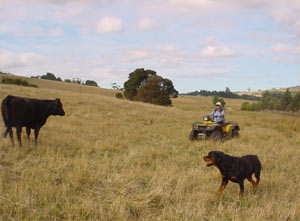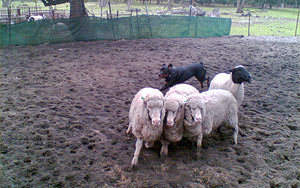Obedience and Working
Herding and the Rottweiler
This article was kindly submitted by Gary Gleeson.
Although an extremely versatile breed used in recent times for many other purposes, the Rottweiler is first and foremost one of the oldest, if not the oldest, of herding breeds with a recorded history of at least 2,000 years. A multi-faceted herding and stock protection dog of exceptional ability, it is capable of working all kinds of livestock under a wide variety of conditions.
The Rottweiler was developed from the dogs used by the Roman legions to herd and guard the cattle brought by them to feed their soldiers. It was an arduous task to drive the cattle and a strong dog with staying power, full of self will and physical strength was needed.
The transition from Roman herding dog to the dog we know today can be attributed to the ambitious Roman Emperors wanting to conquer Europe. As very large armies were required for these expeditions, the logistics of feeding such a large number became a major factor. As there was no form of refrigeration, it meant that the meat accompanied the armies "on the hoof". This meant a dog capable of keeping the herd together during the long marches and protecting it from predators was needed. The "Mastiff type" was well suited to this task as well as shouldering the extra responsibility of guarding the supply dumps at night.
As sites of civilization arose along the legions' roads, so did various types of dogs. One such road led to an army encampment on the Meckar River in what became the state of Swabia in Southern Germany. It flourished as a trading center and was eventually called Rottweil (Rote Wil-"red tiled roofs"). Here, the breed became known as the Rottweiler. The dogs would drive cattle to market; and/or pull carts laden with smaller animals, then once the animals were slaughtered, the dogs pulled the butcher's carts. Tradition has it that purses containing the proceeds of the sale were tied around the dogs' necks to keep the money safe from bandits on the trip home. The rest of the time the dog would live in the house with the family as a household protector.
The Rottweiler was kept busy in these traditional roles until the mid-19th century when railroads replaced droving for getting livestock to market and using dogs to drive animals to market was outlawed in the Germany. According to Adolf Pienkoss, former President of the ADRK, the various German breed fanciers searched for an alternative use for this noble breed and hit upon “Service and Utility” work (Military and Police). In their drive to develop this alternate use for the breed the Germans have all but forgotten the herding origins of the breed.
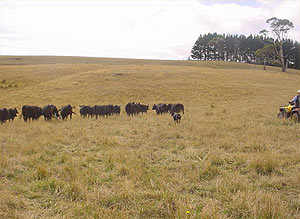
Taringa Murlin, bred and worked by Perina Kentish moving the steers on their Tasmanian property
(Click image to enlarge)
Fortunately Rottweiler Fanciers in other parts of the world, notably North America, have kept the true working ability of the Breed alive. The American and Canadian Kennel Clubs have recognised the Rottweiler as a “Herding Breed” for many years. Herding trials are a well established part of the American Rottweiler circuit, including the US Nationals.
Although not as popular in Australia as newer breeds perhaps more suited to the hot and dry conditions found in many parts of Australia, there are Rottweilers working stock on farms and stations throughout Australia.
WORKING STYLE
Herding instinct is very high. The Rottweiler has a natural gathering style with a strong desire to control. He generally shows a loose-eye and has a great amount of force while working well off the stock. They make much use of their ability to intimidate. Some growers have found that Rottweilers are especially suited to move stubborn stock that simply ignores Border Collies, Kelpies, etc. A Rottweiler will use his body to physically force the stubborn animal to do his bidding if necessary.
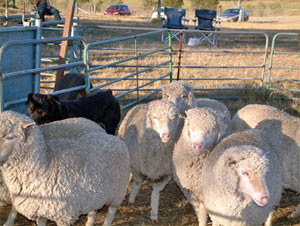
Darkgypsy Fendo Vom Haus (Macca) using his shoulder to push sheep off the fence
(Click image to enlarge)
There is seldom a need to reprimand for gripping or biting as the Rottweiler is unusually inhibited in using mouth on stock. When necessary he will nip with the front teeth only, not using the canines.
The Rottweiler will often carry the head on an even plane with the back or carry the head up but have the neck and shoulders lowered. Some females will lower the entire front end slightly when using eye. Males will also do this when working far off the stock in an open field. This is rarely seen in males when working in confined spaces such as stock yards.
The Rottweiler has a reasonably good natural balance, force-barks when necessary and when working cattle uses a very intimidating charge. There is a natural change in forcefulness when herding sheep. He may use his body and shoulders to guide stock where he wants them to go and for this reason should be used on horned stock with caution.
His great force and control over sheep allows him to expend minimal amounts of energy when working stock. When working cattle (especially strange cattle) the Rottweiler will often seek out the dominant animal and establish his own dominance thereby allowing himself to relax as he works later. Since he does not use mouth he expends great amounts of energy in his intimidating charges and periodic tackles to control unruly cattle. It is therefore necessary for him to establish his control at the start.
When working sheep the Rottweiler shows a gathering/fetching style and reams directions easily. He drives sheep with ease.
If worked on the same stock for any length of time the Rottweiler tends to develop a bond with the stock and will become quite affectionate with them as long as they do as he says.
Originally bred to drive cattle for weeks and months on end, the Rottweiler is a natural trotter and, if built correctly, can trot for long distances. This energy conserving trotting movement is something conformation judges should look for when assessing movement. As with any droving breed, high stepping energy intensive flashy movement is not correct in the Rottweiler.
The more confidence a Rottweiler has the less forceful he becomes unless it is needed and the easier he is to train.
HERDING AND THE ANKC
Around the world, herding dogs have proven themselves to be essential in improving man’s ability to control and move stock. Many herding dogs have working styles very different to the modern sheep dogs we see in Australia today. These different herding styles developed in response to local situations and needs. Herding instinct is a precious part of a herding breed’s heritage. It is also a vital component that can be easily lost when breeding for exhibition in the show ring.
The ANKC Herding Program is designed to preserve the traditional style and herding instinct of these many breeds. Herding Tests and Trials provide a standardised gauge by which a dog’s basic instinct and ability can be measured, and allow dogs to demonstrate the useful functions for which they were originally developed.
ANKC Sanctioned Herding Tests and Trials are formal herding events at which dogs may participate, for championship scores or qualifying scores toward titles, conducted by a Club or Association by obtaining the sanction of the Controlling Body.
Certificate and Title Descriptions
Tests: Trials:
Instinct Test - Certificate (not a title) Herding Started - HS Title
Herding Test - HT Title Herding Intermediate - HI Title
Pre-Trial Test - PT title Herding Advanced - HX Title
Herding Champion - HCH
Despite the fact that the (ANKC approved) FCI standard is clear that the Rottweiler is a herding breed, it took considerable effort to have the Australian National Kennel Council recognize the Rottweiler as a herding breed. In fact it had to be done twice. When the first rules for Herding were released, the Rottweiler was not included. A protest lodged with the ANKC by the Canine Association of Western Australia resulted in new amended rules that included the Rottweiler on the list of “Breeds eligible for Herding Test Program” being issued by the ANKC in October 2000 before ANKC Herding trials commenced. These amended rules were ignored by the Group 5 dominated ANKC Herding Committee. A significant number of members of National Rottweiler Council (Australia) affiliated clubs reported being refused herding training at ANKC affiliated clubs “because Rottweilers are not on the ANKC list”.
One Western Australian enthusiast, Gary Gleeson of Primarch Rottweilers, simply refused to accept this and campaigned for 10 years to rectify the ridiculous situation where the oldest of Herding Breeds was excluded from ANKC Herding. Eventually he mobilized the members of the email list “Rottweilers Australia and New Zealand” to put together a submission to the ANKC through the Group. Several drafts of the submission were circulated through the List. It was then submitted through the West Coast Rottweiler Club of Western Australia (Inc) to the National Rottweiler Council (Australia).
The NRCA adopted the submission and submitted it to the ANKC. As a result the Rottweiler was finally included on the list of “Breeds eligible for Herding Test Program” under the ANKC “Rules and Regulations for Herding” with effect 1 January 2009.
A number of Rottweilers commenced trialling immediately the approval was granted. On the morning of 11th of April 2009 at the first NSW Herding trial for the year, Darkgypsy the Jewel (Opal) handled by Neville Bennett became the first Rottweiler in Australia to pass the Herding Instinct Test under Judge Glen Cunningham. Later the same day she obtained the first of the two passes required in the Herding Test. On the 3rd of May 2009 Opal passed for the second time under Pat Finlayson giving her the “HT” Title.
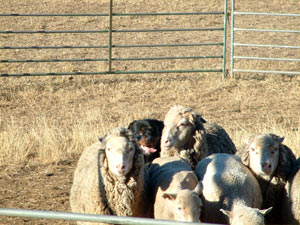
Darksupreme Angel ET HT (Angel) bred and worked by Neville and Sue Bennett, NSW
(Click image to enlarge)
Not to be outdone, Opal’s daughter Darksupreme Angel, who had featured in the NRCA’s submission to the ANKC, passed her Herding Instinct test on 3/5/09 under Mrs. Pat Finlayson. She then achieved two passes of the Herding Test, the first under Alice Baxter and the second under Pat Finlayson 3/5/09 also giving her the HT Title.
Neville had achieved the double with both of his Rottie bitches achieving “Herding Test” titles on the same day, the first Australian Rottweilers to do so.
At the time of writing Opal also had the first pass towards her “Pre Trial Tested” title. Neville hoped to get the other pass soon giving her the title and earning the right to enter full Herding Trials.
Fittingly, Primarch Velvet Delite handled by Gary Gleeson also passed the ANKC’s “Herding Instinct Test” at the first Herding trial held in Western Australia in 2009, a week after the first NSW trial.
At the time of writing several other Rottweilers are in various stages of training. It hopefully will not be long before we see the first Australian Rottweiler titled “Herding Champion”.
For more information on Herding in your state contact the Herding Committee of your Canine Control.
REFERENCES:
- American Kennel Club Herding Regulations. The full document is available at http://www.akc.org/events/herding”/
- Canadian Kennel Club Rottweiler Breed Standard. Available on line at http://www.ckc.ca
- F.C.I. Standard No 147 “The Rottweiler” dated 11th September 1992
Adopted in Australia 1st January 1994, Amended May 2001
Country of Origin: Germany, Translated by - Mrs C. Seidler Country of Origin – Germany. Available on Australian National Kennel Council website http://www.ankc.aust.com/
- Australian National Kennel Council Rules and Regulations for Herding. Available online at http://ankc.org.au/AboutUs/?id=1253
- Pienkoss, Adolf. The Rottweiler, 3rd revised and updated edition, Internationale Foederation der Rottweilerfreunde (IFR), Borken, Germany, 2008
-------------------------------------------------------------------------------------------------------------------------------------
Advertisements
